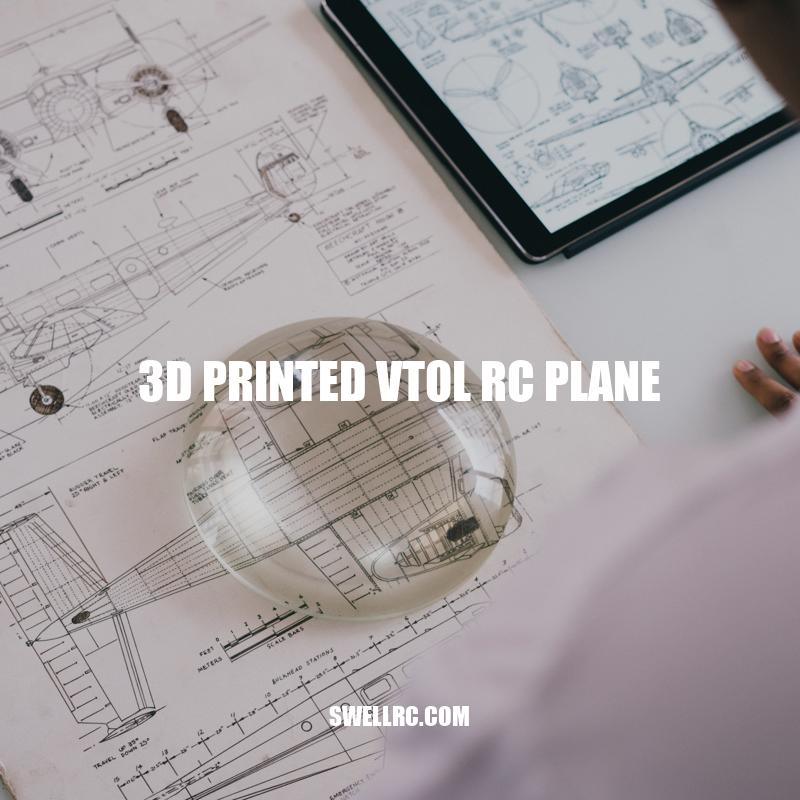3D Printed VTOL RC Planes: The Future of Model Aviation
3D printing has revolutionized the way we create and manufacture objects. The technology has opened up new possibilities for hobbyists and professionals to bring their ideas to life. One such exciting application of 3D printing is in the creation of VTOL RC planes. VTOL, or vertical takeoff and landing, planes are different from traditional RC planes in that they can take off and land vertically. This makes them ideal for flying in small spaces and hovering in place. Increasingly popular among enthusiasts, 3D printed VTOL RC planes offer a number of benefits over traditional planes. In this article, we will look at the process of 3D printing a VTOL RC plane, design considerations, challenges faced, and tips for overcoming them.
3D Printing Process for VTOL RC Planes
The process of 3D printing a VTOL RC plane involves several steps, including:
- Choosing the right 3D printer for the job. Consider factors such as build volume, resolution, and filament options. There are several 3D printers available that specialize in printing RC planes.
- Selecting the right materials. PLA and PETG are popular materials for 3D printing VTOL RC planes because of their rigidity and durability.
- Finding or designing a 3D printable VTOL RC plane. Websites such as Thingiverse and MyMiniFactory offer a range of 3D printable designs, or you can create your own using CAD software.
- Slicing the model. This is the process of converting the 3D model into a format that the printer can understand.
- Printing the parts. Depending on the size and complexity of the model, printing the parts can take anywhere from a few hours to several days.
- Assembling the plane. Once all the parts have been printed, they need to be assembled into the final product. This can involve using screws, glue, or other bonding agents.
If you’re new to 3D printing, there are plenty of resources available to help you get started. Websites such as 3D Hubs and All3DP offer reviews and comparisons of different 3D printers, as well as tips and tricks for getting the most out of your machine. Additionally, many 3D printer manufacturers offer tutorials and support for new users.
How do VTOL planes work?
VTOL (Vertical Takeoff and Landing) planes are aircraft that can take off and land vertically without needing a runway or a long airstrip. Here is a brief explanation of how VTOL planes work:
- VTOL planes use special engines that can swivel to direct thrust straight downwards, allowing them to take off and land vertically.
- Some VTOL planes also have additional lift-generating mechanisms, like jet fans or rotors, which help them take off and land vertically.
- VTOL planes are highly maneuverable and can hover in place, making them ideal for military and rescue operations.
If you want to learn more about VTOL planes, check out aviation websites like Aviation Week or FlightGlobal. You can also look for books on the topic on Amazon or other book retailers.
Choosing the Right 3D Printer for VTOL RC Planes
When it comes to 3D printing a VTOL RC plane, choosing the right 3D printer is essential. Here are some important factors to consider:
- Build volume: A larger build volume means you can print larger parts without having to split them up into smaller pieces. This is important for printing larger VTOL RC planes.
- Resolution: A higher resolution means you can print more detailed parts with smoother surfaces. This is important for printing parts that need to fit together precisely, such as gears and propellers.
- Filament options: Some 3D printers only support certain types of filament, such as PLA or ABS. Make sure the printer you choose supports the filament materials you plan to use.
- Price: 3D printers can range in price from a few hundred dollars to several thousand. Consider your budget when choosing a printer.
Here are a few 3D printers that are popular for 3D printing RC planes:
| 3D Printer | Build Volume | Resolution | Price |
|---|---|---|---|
| Creality Ender 3 | 220 x 220 x 250 mm | 100 microns | $200 – $300 |
| Prusa i3 MK3S | 250 x 210 x 210 mm | 50 microns | $749 |
| Ultimaker S5 | 330 x 240 x 300 mm | 20 microns | $5,995 |
It’s important to note that there are many other 3D printers available that are suitable for 3D printing VTOL RC planes. Do your research and choose a printer that meets your specific needs and budget.
Why are 3D printed materials important in an RC aircraft?
- 3D printing enables custom design and manufacture of parts that may not be available or easily replicable using traditional manufacturing methods
- Manufacturing time is drastically reduced as parts can be printed quickly and efficiently
- The weight of the RC aircraft can be reduced by using 3D printed parts made from lightweight materials such as nylon or carbon fiber
- 3D printing allows for the production of complex geometries, which can increase the overall performance of the RC aircraft
There are various websites and products available for 3D printing materials for RC aircraft. One such website is www.makergeeks.com which offers a range of filaments for 3D printing, including lightweight materials suitable for RC aircraft. Another option is the use of a 3D printer such as the Creality Ender 3, available on websites such as Amazon and Best Buy, which can be used to print custom parts for RC aircraft.
Designing a Successful VTOL RC Plane with 3D Printing
Designing a successful VTOL RC plane with 3D printing requires careful planning and attention to detail. Here are some tips to help you create a high-quality plane:
- Balance: Ensuring the plane is balanced is essential for stable flight. Consider the weight of each component and adjust as needed.
- Aerodynamics: Design the plane with aerodynamics in mind, using features such as a tapered wing profile and a streamlined body.
- Print orientations: When 3D printing, it’s important to consider the orientation in which each part should be printed. Some parts, such as propellers, may need to be printed in a specific orientation to ensure optimal performance.
- Assembly: Design the plane with assembly in mind, ensuring that each component can be easily attached and secured in place.
If you’re new to 3D printing, there are many free designs available online that can be printed and assembled into a VTOL RC plane. Here are a few websites that offer free RC plane designs:
- Thingiverse: Thingiverse is a popular website for downloading free 3D printable designs. They offer a large selection of RC plane designs, including VTOL planes.
- MyMiniFactory: MyMiniFactory is another website that offers free 3D printable designs. They have a smaller selection of RC plane designs, but they have several high-quality VTOL designs available.
- RCGroups: RCGroups is a forum dedicated to RC enthusiasts. They have a section dedicated to sharing 3D printable RC plane designs, including VTOL planes.
When downloading an RC plane design, be sure to check the printing instructions and materials recommendations to ensure you have everything you need to print and assemble the plane.
How to Design the Body of an RC Plane?
Designing the body of an RC plane can be challenging, but with proper planning and knowledge, it can be done effortlessly. Here are a few tips that can help you design an efficient RC plane body:
- Decide on the materials to be used for the body
- Create a blueprint of your RC plane
- Make sure the wings and the center of gravity are balanced
- Choose the right motor and battery for your plane
There are several websites and products available online that can help you design an RC plane. You can check out the Flite Test website for tutorials and free plans, and the HobbyKing website for various RC plane parts. Using reliable resources such as these can make the design process more manageable, and ensure that you create a successful RC plane.
Challenges of 3D Printing an RC Plane
While 3D printing is an exciting and innovative way to build an RC plane, it does have its challenges. Here are some common issues that can arise when 3D printing an RC plane, and how to overcome them:
- Warping: Warping occurs when the edges of a printed object curl or lift up during printing. To avoid warping, use a heated build plate and ensure proper bed adhesion by cleaning the surface and applying a suitable adhesive.
- Layer separation: This happens when the layers of a printed object separate from each other during printing. To prevent layer separation, adjust the printing temperature and speed, and choose the right type of filament for the job.
- Structural integrity: Large and complex designs can be challenging to print successfully without compromising the overall strength of the finished plane. To ensure adequate strength and durability, consider adding structural reinforcements, such as internal ribs, or using filaments with added strength, such as carbon fiber or nylon.
While these challenges may seem daunting, with some practice and experimentation, they can be overcome. Additionally, there are resources available online to help new and experienced 3D printers troubleshoot problems and find solutions.
Conclusion
3D printing offers an exciting way to build a VTOL RC plane. With careful planning, attention to detail, and the right resources, you can create a high-quality plane that performs well. Whether you’re a seasoned RC hobbyist or new to the world of 3D printing, the possibilities are endless when it comes to designing and printing your own VTOL RC plane. Ready to get started? Grab your 3D printer, choose a design, and take to the skies in your very own custom-built VTOL RC plane!



